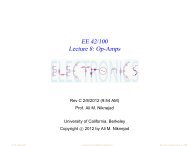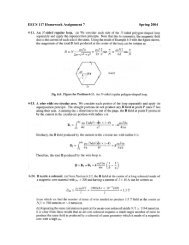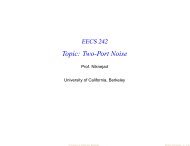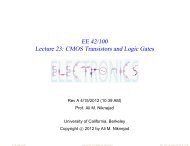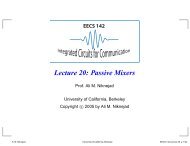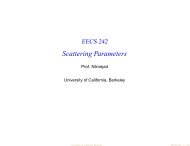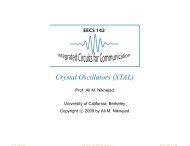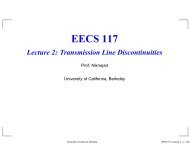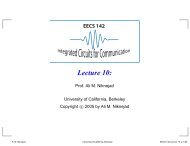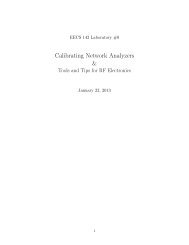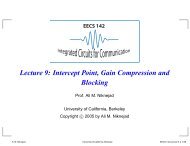Siliconization Of 60 GHz - Ali M. Niknejad
Siliconization Of 60 GHz - Ali M. Niknejad
Siliconization Of 60 GHz - Ali M. Niknejad
Create successful ePaper yourself
Turn your PDF publications into a flip-book with our unique Google optimized e-Paper software.
simplifying board and system design by containing all<br />
high-frequency routing within the CMOS die and chip<br />
package. Achieving full 10 m NLOS coverage at the<br />
required data rates requires many independent antennas<br />
and partial radio chains. Thus, this fully integrated<br />
radio chip, containing all radio chains and antennas,<br />
represents a significant advance in the degree of parallelism<br />
achieved at the RF level for high-volume consumer<br />
wireless communications products.<br />
Standardization<br />
There are currently many standards for <strong>60</strong>-<strong>GHz</strong> wireless<br />
communication, including IEEE 802.15.3c [16], IEEE<br />
802.11ad (a high-speed WLAN network) [17], the<br />
ECMA-387 standard [18], WirelessHD [15], and the<br />
WiGig standard [19]. Each standard is formed by a different<br />
community of potential users of the technology,<br />
such as consumer electronics companies (WirelessHD)<br />
versus the PC industry (WiGig). Most of the standards<br />
are focusing on very high speed communication (1–5<br />
Gb/s) to enable wireless HDMI replacement.<br />
Unfortunately the process of standardization is<br />
highly political and controversial, often to the detriment<br />
of the technology and ultimately to the consumers.<br />
This was certainly the case for UWB technology and<br />
may have contributed to the delay of products and to<br />
the eventual downfall of UWB. It is imperative that the<br />
same mistakes are not made with <strong>60</strong> <strong>GHz</strong>. Even though<br />
different standards are needed for different applications,<br />
interoperability between the standards is key. For<br />
instance, a simple single carrier low range link should<br />
be the fall-back mode for all the different <strong>60</strong>-<strong>GHz</strong> radios.<br />
A single carrier is preferred, even though it may have a<br />
shorter range due to multipath effects, because it can be<br />
easily integrated into small low-power portable devices.<br />
This is in stark contrast to systems using OFDM, which<br />
require high power for the ADC and digital baseband<br />
processor (FFT operation).<br />
Conclusion<br />
Silicon based <strong>60</strong> <strong>GHz</strong> is a promising technology for<br />
high data rate communication. Gordon Moore is best<br />
known for his Law predicting the continued exponential<br />
growth in the number of transistors fabricated in<br />
silicon integrated circuits. In the same paper, though, he<br />
also predicted that someday the same trend may benefit<br />
microwave and millimeter-wave phased arrays. Today,<br />
with the convergence of high-speed silicon technology<br />
and the market demands for high data rates driven by<br />
high-definition video, <strong>60</strong> <strong>GHz</strong> is at the right place at<br />
the right time. Key challenges moving forward include<br />
power and size reduction to enable adoption in mobile<br />
devices and interoperability between the standardization<br />
efforts to ensure a universal <strong>60</strong>-<strong>GHz</strong> communication<br />
link, much like today’s wired USB cables. If <strong>60</strong> <strong>GHz</strong><br />
is widely deployed in consumer electronics devices, we<br />
may have to coin a new millimeter-wave Moore’s Law.<br />
Acknowledgments<br />
The <strong>60</strong>-<strong>GHz</strong> research using silicon technology was<br />
sponsored by the visionary DARPA TEAM Program,<br />
managed by Dr. Reuss, Dr. Radack, and Dr. Fritze. The<br />
author thanks NSF (Infrastructure Grant No. 0403427),<br />
DARPA and the FCRP C2S2 program for continued<br />
funding of millimeter-wave silicon research. The<br />
authors also thank ST Microelectronics and IBM for<br />
the donation of silicon foundry services.<br />
References<br />
[1] A. Maltsev, R. Maslennikov, A. Sevastyanov, A. Khoryaev, and A. Lomayev,<br />
“Experimental investigations of <strong>60</strong> <strong>GHz</strong> wireless systems in office<br />
environment,” IEEE J. Select. Areas Commun., vol. 27, no. 8, Oct. 2009.<br />
[2] D. A. Sobel and R. W. Brodersen, “A 1Gbps mixed-signal analog<br />
front end for a <strong>60</strong> <strong>GHz</strong> wireless receiver,” in Proc. IEEE Symp. VLSI<br />
Circuits, June 2008, pp. 156–157.<br />
[3] A. Babakhani, X. Guan, A. Komijani, A. Natarajan, and A. Hajimiri,<br />
“A77-<strong>GHz</strong> phased array transceiver with on-chip antennas<br />
in silicon: Receiver and antennas,” IEEE J. Solid-State Circuits, vol.<br />
41, no. 12, pp. 2795–806, Dec. 2006.<br />
[4] K. Scheir, S. Bronckers, J. Borremans, P. Wambacq, and Y. Rolain,<br />
“A 52<strong>GHz</strong> phased-array receiver front-end in 90nm digital CMOS,”<br />
in ISSCC Dig. Tech. Papers, Feb. 2008, pp. 184–185.<br />
[5] S. K. Reynolds, B. A. Floyd, U. R. Pfeiffer, T. Beukema, J. Grzyb, C.<br />
Haymes, B. Gaucher, and M. Soyuer, “A silicon <strong>60</strong>-<strong>GHz</strong> receiver<br />
and transmitter chipset for broadband communications,” IEEE J.<br />
Solid-State Circuits, vol. 41, no. 12, pp. 2820–2831, Dec. 2006.<br />
[6] A. Parsa and B. Razavi, “A <strong>60</strong><strong>GHz</strong> CMOS receiver using a 30<strong>GHz</strong><br />
LO,” in ISSCC Dig. Tech. Papers, Feb. 2008, pp. 190–191.<br />
[7] S. Pinel, S. Sarkar, P. Sen, B. Perumana, D. Yeh, D. Dawn, and J.<br />
Laskar, “<strong>60</strong><strong>GHz</strong> single chip 90 CMOS radio,” in ISSCC Dig. Tech.<br />
Papers, Feb. 2008.<br />
[8] J. Lee, Y. Huang, Y. Chen, H. Lu, and C. Chang, “A low-power fully integrated<br />
<strong>60</strong><strong>GHz</strong> transceiver system with OOK modulation and on-board<br />
antenna assembly,” in ISSCC Dig. Tech. Papers, Feb. 2009, pp. 316–317.<br />
[9] A. Tomkins, R. A. Aroca, T. Yamamoto, S. T. Nicolson, Y. Doi, and S. P.<br />
Voinigescu, “A zero-IF <strong>60</strong><strong>GHz</strong> transceiver in 65nm CMOS with > 3.5Gb/s<br />
links,” in IEEE CICC Dig., San Jose, CA, Sept. 2008, pp. 471–474.<br />
[10] C.-H. Wang, H.-Y. Chang, P.-S. Wu, K.-Y. Lin, T.-W. Huang, H. Wang,<br />
and C.-H. Chen, “A <strong>60</strong>-<strong>GHz</strong> low power six-port transceiver for gigabit<br />
software-defined transceiver,” in ISSCC Dig. Tech. Papers, Feb. 2007.<br />
[11] C. Marcu, D. Chowdhury, C. Thakkar, L.-K. Kong, M. Tabesh, J.-D.<br />
Park, Y. Wang, B. Afshar, A. Gupta, A. Arbabian, S. Gambini, R.<br />
Zamani, A. M. <strong>Niknejad</strong>, and E. Alon, “A 90 nm CMOS low-power<br />
<strong>60</strong><strong>GHz</strong> transceiver with integrated baseband circuitry,” in ISSCC<br />
Dig. Tech. Papers, Feb. 2009, pp. 314–315.<br />
[12] B. Afshar, Y. Wang, and A. M. <strong>Niknejad</strong>, “A robust 24mW <strong>60</strong> <strong>GHz</strong><br />
receiver in 90 nm standard CMOS,” in ISSCC Dig. Tech. Papers, Feb.<br />
2008, pp. 182–183.<br />
[13] C. Marcu, D. Chowdhury, C. Thakkar, J.-D. Park, L.-K. Kong, M.<br />
Tabesh, Y. Wang, B. Afshar, A. Gupta, A. Arbabian, S. Gambini, R.<br />
Zamani, E. Alon, and A. M. <strong>Niknejad</strong>, “A 90 nm CMOS low-power<br />
<strong>60</strong><strong>GHz</strong> transceiver with integrated baseband circuitry,” IEEE J. Solid-<br />
State Circuits, to be published.<br />
[14] J. M. Gilbert, C. H. Doan, S. Emami, and C. B. Shung, “A 4-Gbps<br />
uncompressed wireless HD A/V transceiver chipset,” IEEE Micro,<br />
vol. 28, no. 2, pp. 56–64, Mar./Apr. 2008.<br />
[15] WirelessHD. [Online]. Available: http://www.wirelesshd.org<br />
[16] IEEE 802.11 Working Group, Wireless PAN Task Group 3c. (2009).<br />
Millimeter Wave Alternative PHY. [Online]. Available: http://<br />
www.ieee802.org/15/pub/TG3c.html<br />
[17] IEEE 802.11 Working Group. Very high throughput in <strong>60</strong> <strong>GHz</strong>.<br />
[Online]. Available: http://www.ieee802.org/11/Reports/tgad_<br />
update.htm<br />
[18] Standard ECMA-387. (2008, Dec.). High Rate <strong>60</strong> <strong>GHz</strong> PHY, MAC<br />
and HDMI PAL [Online]. Available http://www.ecma-international.org/publications/standards/Ecma-387.htm<br />
[19] Wireless Gigabit Alliance. [Online]. Available: http://wirelessgigabitalliance.org/<br />
[20] A. M. <strong>Niknejad</strong> and H. Hashemi, Eds., mm-Wave Silicon Technology:<br />
<strong>60</strong> <strong>GHz</strong> and Beyond, Springer, 2008.<br />
February 2010 85


